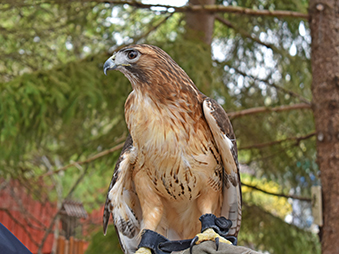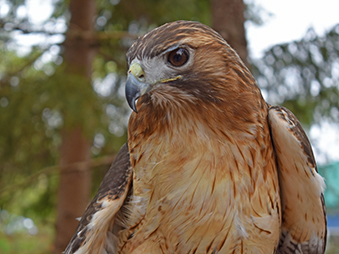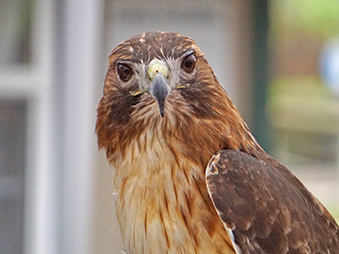Buteo jamaicensis | Red-tailed Hawk
Name: Nicodemus (Female)



Meet Nicodemus: Our Red-Tailed Hawk
Say hello to Nicodemus, our sharp-eyed and regal red-tailed hawk! This magnificent raptor is one of the most widespread birds of prey in North America, found from Alaska and Canada all the way to Panama—and even parts of the Caribbean. With their broad wings, striking red tail, and unmistakable cry, red-tailed hawks are true symbols of the open skies.
A Master of the Skies
Red-tailed hawks are adaptable hunters that thrive in diverse habitats—woodlands, grasslands, prairies, agricultural fields, and even bustling cities. From towering trees to powerlines and skyscrapers, these birds find prime perches to survey the land below.
Their eyesight is eight times stronger than ours, enabling them to spot a mouse from over 100 feet away! You’ll often see them circling above open fields, gliding effortlessly on wind currents, patiently waiting for movement that signals prey.
Unlike falcons that dive at blazing speeds, red-tailed hawks employ a slow, deliberate dive. Nicodemus and his wild cousins hover and glide with calculated precision before swooping down to snatch up mice, rabbits, snakes, or small birds with their razor-sharp talons.
Life and Diet
In the wild, red-tailed hawks typically live up to 12 years. But with proper care and regular meals in human care, they can live more than twice as long—some reaching over 29 years!
At the zoo, Nicodemus enjoys a nutritious diet that includes frozen-thawed rats, quail, mice, chicks, specialized bird-of-prey meat, and a monthly knuckle bone to keep her beak healthy and strong.
Despite their size and power, red-tailed hawks are surprisingly lightweight. Even the largest females weigh only about three pounds. That low body weight is a key adaptation for flight—allowing them to soar for hours with minimal effort.
Courtship and Nesting Behavior
Red-tailed hawks are monogamous and form lifelong pair bonds, usually only finding a new mate if one passes away. Their courtship is a spectacular aerial show: males perform dives and swoops, and sometimes pairs lock talons midair, spiraling toward the ground before parting just in time.
They build large nests—around 3 feet high and up to 38 inches wide—that they have been known to reuse for several years in a row. Females can lay 1–5 eggs each breeding season. Both parents take turns incubating, though the female does most of it while the male hunts and protects the nest.
Once chicks hatch, they depend entirely on their parents. The female stays close, and the male supplies food for both her and the young.
Territory, Behavior, and Diversity
Red-tailed hawks are highly territorial—especially the females—and will aggressively defend their nesting area from other hawks, eagles, and even great horned owls. They can also be fierce competitors, often fighting with owls over nest sites, even destroying each other’s nests.
These hawks are not just solo hunters. They've been observed hunting in pairs, strategically positioning themselves on opposite sides of a tree to ambush prey.
While most adult red-tailed hawks have the signature rusty-red tail, some subspecies—like the “Harlan’s Hawk” (Buteo jamaicensis harlani) found in Alaska and Canada—feature marbled gray, brown, and white tails. This variation was once thought to be a different species altogether!
Interestingly, in many movies and commercials, when you hear an “eagle scream," you're probably hearing a red-tailed hawk. Hollywood often substitutes the hawk’s dramatic cry for the less intense call of a bald eagle.
Sound Comparison
- Red-tailed Hawk Call
- Bald Eagle Call
Fact Sheet
Taxonomy
Genus: Buteo | Species: jamaicensis |
Kingdom: Animalia | Phylum: Chordata | Class: Aves | Order: Falconiformes | Family: Accipitridae |
Favorite Enrichment Type
Items she can use as nesting material such as straw, twigs, hay, pine needles, and newspaper strips.
Life Span
- In the Wild: 12 to 21 years
- In Human Care: Up to 29 years
Diet
- In the Wild: Mice, rabbits, snakes, and birds.
- At the Zoo: Frozen thawed rats, quail, mice, chicks, specialized Bird of Prey meat, and a knuckle bone once a month for beak health.
Geographic Range
Found throughout the United States, Canada, Mexico, and Central America.
Habitat
Typically found in open areas with high perching places nearby from which they can watch for prey. Specific habitats include woodlands, prairies, grasslands, agricultural fields, or swamps.
Fun Facts
- Male and female red-tailed hawks look nearly identical, but females are about 25% larger.
- Juveniles have yellowish-grey eyes that darken to deep brown as they mature.
- There are 14 recognized subspecies of Buteo jamaicensis, differentiated by color and geographical range. Here in Michigan, the most common is Buteo jamaicensis borealis.
- Want to learn which subspecies live in your area? Check out the Red-tailed Hawk Project’s Subspecies Guide!
- Ever noticed the dramatic “eagle scream" in movies? That’s usually the call of a Red-tailed Hawk—Bald Eagles have a much softer, chirpy call. Check them out below!
- Red-tailed Hawk Call
- Bald Eagle Call
- Red-tailed Hawk Call
- Red-tailed Hawks have been seen hunting cooperatively—a rare trait for raptors—especially when ambushing clever prey like squirrels.
- Red-tailed hawks are found across North America and into Central America and the Caribbean, making them one of the continent’s most successful birds of prey.
Status: Least Concern
Conservation and Protection
Red-tailed hawks are protected under the Migratory Bird Treaty Act of 1918, which makes it illegal to hunt, capture, or harm them. This international treaty—shared by the U.S., Canada, Mexico, Japan, and Russia—ensures the safety of countless migratory bird species. Learn more on the U.S. Fish & Wildlife Service website.
Though considered a species of least concern, red-tailed hawks still face threats from human activity:
- Window Collisions: Birds often mistake reflective glass for open sky. Use decals or window film in a 2" x 2" pattern to help birds recognize glass as a barrier.
- Fishing Line and Lead: Improperly discarded fishing line can entangle birds. Lead in ammunition or fishing tackle can poison birds that scavenge prey. Switch to lead-free alternatives and always dispose of waste properly.
These raptors play a vital role in maintaining healthy ecosystems by controlling rodent populations—about 80–85% of their diet includes small mammals like mice and moles that can damage crops.
How to Find Me
After entering the zoo through the admissions booth, head to the right to enter the Forgotten Forest! Once in the Forgotten Forest, she is located next to our Barred Owl.
